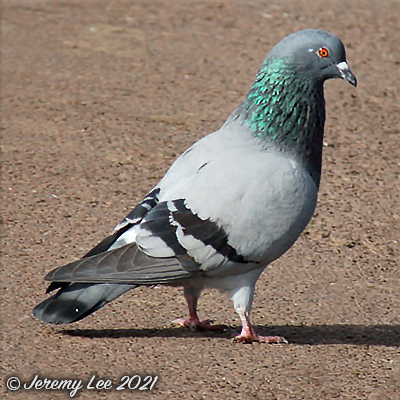
 |
|
Scientific Classifications explained » Amphibians » Ants » Aphids » Bees » Beetles » Birds » Bugs » Butterflies » Caterpillars » Damselflies » Dragonflies » Earwigs » Flies » Frog/Leafhoppers » Fungi » Galls » Grasshoppers » Harvestmen » Hoverflies » Lacewings » Ladybirds » Leaf Mines » Lichens » Mammals » Millipedes » Mosses » Moths » Sawflies » Slugs » Snails » Spiders » Trees » Wasps » Wild Flowers » Woodlice |
UK Nature > Birds > Columba livia

Scientific Name: Columba livia Common Name: Rock Dove/Feral Pigeon Columba livia, more commonly known as the domesticated Feral or Town Pigeon, is descended from the wild Rock Dove, and can have similar plumage, though there are also many mixes of black, browns, white and piebald. Feral Pigeons can be larger than Rock Doves owing to their mixed breeding. The adult Rock Dove is smaller than a Wood Pigeon. The underparts and upper parts are blue-grey, but the back is paler, and there is always a white patch on its rump. The neck is iridescent with green and purple and the wings are grey except for two distinct black wing-bars. The eyes and legs are red. Feral Pigeons have adopted ledges on buildings and other structures in our towns and cities for roosting/nesting, whereas the Rock Dove uses cliffs. They are very common throughout the UK in urban areas and feed on grain, seeds and kitchen scraps, being often fed by the public in town centres, parks and gardens. |
|

https://www.uknature.co.uk is a website dedicated to showing the immense diversity of UK nature and wildlife. Our vast range of habitats, from lowland arable to snow covered mountains, from storm-ravaged coastlines to peaceful inland freshwater lakes and rivers, from dry, sandy heaths to deciduous and coniferous forests, all these habitats contribute to the abundance of UK nature. We have wild birds in huge numbers either residing or visiting our shores (597 recorded species as at July 2013) and we must also not forget the humble back garden with its grass lawns, flower beds filled with nectar rich flowers, shrubs and trees, all designed to attract huge numbers of insects such as bees, moths, butterflies and hoverflies; and finally the small ponds which provide safe havens for frogs, toads, newts and even slow worms and grass snakes. www.uknature.co.uk is the showcase for my personal passion, photographing uknature in all its glory. I sincerely hope you all enjoy the fruits of my labours. This site and all images contained therein is © Jeremy Lee 2004 - 2021. All Rights Reserved. Site design by Jeremy Lee. Site development & IT Support by Stuart Lee. |